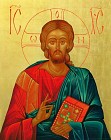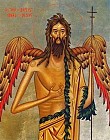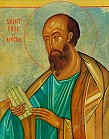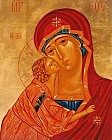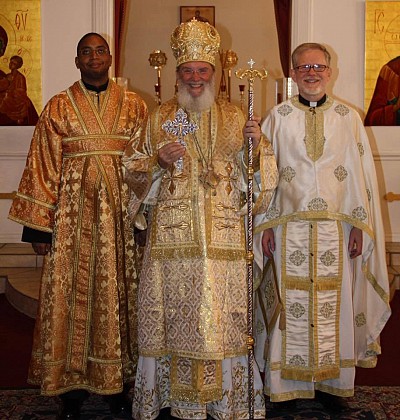Linda is a graduate of Lamar University in Beaumont, Texas with a Bachelor of Fine Arts in Graphic Design. She studied iconogaphy under Yuri Sidorenko and John Lickwar, becoming licensed by Metropolitan Philip. She has written the Iconostatsis for St. Luke Antiocian Church in Abilene, Texas, as well as numerous private commissions.
"The Divine Icon"
“Holiness and intelligence of soul are to be recognized from a man’s eye, walk, voice, laugh, and the way he spends his time and the company he keeps. Everything is transformed and reflects an inner beauty”. St. Anthony the Great
Icons, or images of Holy People, reflect this transformation, this inner spiritual beauty of an ordinary person who has extraordinary faith, humility and obedience to God. These holy people, Saints, are depicted in icons. They serve as role models and inspiration, as intercessors during difficult times in life. They are the Image of Christ who created them. God is Love and because we are created in His Image, we are Love. We are God’s living icon.
The word “icon” comes from the Greek “eikon” meaning “image, representation or portrait”. Looking at the earliest Old Testament “Divine Images” we see the Cherubim carved on the Ark of the Covenant, frescos in the ancient synagogues depicting scenes of Abraham and his sacrifice of Isaac and Daniel in the den with the lions. But we do not see an image of God Himself. God’s Presence was depicted only as The Hand of God, the Temple or the Ark of the Covenant.
Greeks and Romans of this time venerated portraits of their gods and emperors who were considered “Divine”. Man has always desired to portray the Divine so that in seeing its image, he could better understand it and commune with it.
It was only natural that Christians wanted to depict Christ as well. To paint a picture of Him, not only to remember what He looked like, but to portray the Divine. But remembering God’s commandment, “Thou shalt not make any graven image”, wasn’t it wrong to portray the Divine? In John’s Gospel he said, “No man has seen God”. These two things would be the main arguments that the iconoclasts would later use to justify destroying the icons. But Christ was not only Divine, He was also human. And because He came to earth as a human, He enabled us to portray His human face and body. This is the reason we can paint a picture of Him even though He is God. He is the Holy Trinity, one in essence with the Father and the Holy Spirit. So when we see an image of Christ, we also see His complete person, the Father, the Son and the Holy Spirit. The Holy Trinity. The Divine.
Early Christian symbols and images representing Christ such as the Fish, The Shepherd and The Lamb were drawn on the walls of the catacombs. Scenes depicting events in the life of Christ were used to teach the mystery of Salvation to the new believers, many of whom were soon to become martyrs. The early Christians never worshipped these symbols or paintings. They only used them for their understanding of Christ and His teachings. These symbols not only had a teaching purpose, they also had a spiritual aspect. It was not only a way to attempt to understand God and His Word, it was also a way of communion with Him. It was a transformation from the earthly and material to the Heavenly and illumined.
The Roman Emperor, Constantine, declared Christianity to be the official religion of the Roman Empire and in 330 and moved the capital from Rome to Byzantium, a small but very important trading city on the peninsula connecting the Mediterranean and Black Sea. It is the name of this city, Byzantium, from which comes the word Byzantine. The Byzantine Empire lasted a thousand years and it was in this city that Byzantine iconography began to develop and flourish now that the artists were free to paint. The city of Byzantium was renamed Constantinople, after Emperor Constantine, and is now known as Istanbul.
The new Christian artists began painting images, or icons, of Holy persons using a “new style” of art. They wanted to break away from everything pagan. So their “new” Christian art was not sensual and naturalistic like the Roman-Greco art of the day but rather a stylized, unsentimental harmony that expressed a “spiritual beauty”. They wanted to depict a person who had been transformed by the Holy Spirit. One who had, by God’s Grace, attained the virtues of love, faith, meekness and humility.
But how was the iconographer to portray this inner “spiritual beauty? This “transformed” person? Many figures in early icons were shown in the “orans” position, with arms uplifted in the ancient position of prayer. The internal, spiritual state of the person was more important than the drama of the situation. The early Christian had to be prepared to suffer and die for his faith, so he was reminded, when he looked at these images, that prayer would strengthen and calm him, preparing him for any test he had to face.
The face of the Saint in the icon is stylized. It reflects a spiritual beauty rather than a purely natural beauty.
The ears of the Saint are closed. Closed to gossip, slander and distraction. Hearing and obeying only the Word of God.
The eyes of the Saint are large, seeing only the Love, the Image of God in all people and things.
The mouth of the Saint is closed signifying that the tongue must be controlled and should only speak what is edifying to one another. Our speech must be transformed into God’s Words.
The hands of the Saint are either in the form of prayer, giving a blessing or for works of charity. The fingers and hands are elongated, being transformed by doing God’s Will.
The feet of the Saint walk in the path of God.
By submitting ourselves to the Will of God, our bodies come into a harmony with God, as He created us to be. Union with God, or “Theosis”, happens when God’s life fills and transforms us.
Even when we see an icon of a martyr who is being tortured or beheaded, he is portrayed as calm, submissive and totally in union with God. There is no need for great emotionalism or theatricals, as so often seen in Western paintings. We see this peace, this complete submission to God in the Saint’s face and his demeanor. We believe that, because of God’s Great Love and Mercy, this Holy Person is in His Presence and hears our prayer. We attempt to emulate the love and faith of the Saint. Their image reminds that it is possible for us, too, to become Holy.
Every color in an icon symbolizes something Divine. Blue is the color of Heaven, the mystical life, and the garments of Mary, Mother of God.
Red is the blood of the martyrs and their garment. It is the color of the robe of Christ, of life, vitality and beauty.
Purple depicts royalty, wealth and power.
Gold symbolizes God’s Divine presence in all creation, His Glory, Splendor and Divine Energy.
White represents purity, innocence and God’s Uncreated Light.
There are no shadows in an icon because God’s Light fills and permeates the Saint. The body of the Saint radiates this “uncreated light”, shining with a Divine Light that illumines all things, thereby, casting no shadows.
Traditionally Iconographers do not sign their name on the front of an icon. This would call attention to themselves. They either remain anonymous, or sign the back of the icon printing above their name, “by the hand of” or “through the hand of”, believing that God has painted the icon through their hand for His Glory and for the salvation of those who venerate it and pray before it.
Iconographers are said to “write” an icon because, in essence, they are writing the theology of the Church in depicting the saints, their attributes and the Feast Days. They follow, without change, the images that have been passed down by generations of Holy Iconographers. If they add undue emotion, naturalism or their own interpretation they would be altering the dogma of the Church upon which these icons are based.
Through Christ, the image of God has been renewed in us as we are transformed by the Grace of the Holy Spirit. We are God’s living icons.
